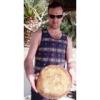
Horst Bandel's Black Pumpernickel
Horst Bandel's Black Pumpernickel.
This is a recipe from "Bread: A Baker's Book of Techniques and Recipes" by Jeffrey Hamelman. A number of TFL regulars have posted on this recipe, notably,
ehanner: http://www.thefreshloaf.com/node/16501/learning-pumpernickel and http://www.thefreshloaf.com/node/16348/horst-bandel039s-black-pumpernickel-bread
txfarmer: http://www.thefreshloaf.com/node/13965/still-struggling-horst-bandel%E2%80%99s-black-pumpernickel and http://www.thefreshloaf.com/node/14315/horst-bandel%E2%80%99s-black-pumpernickel-finally
and Shiao-Ping: http://www.thefreshloaf.com/node/12790/horst-bandel039s-black-pumpernickel
This is the recipe and formula I adapted and used
|
Material |
Formula [% of flour(??)] |
Recipe [grams] |
|
Rye Sour Dough |
|
|
|
Dark Rye Flour |
30 |
300 |
|
Water |
30 |
300 |
|
TOTAL |
60 |
600 |
|
Soaked Bread |
|
|
|
Old Bread |
11 |
110 |
|
Water |
17.7 |
177 |
|
TOTAL |
28.7 |
287 |
|
Soaked Rye Berries |
|
|
|
Whole Rye Berries |
20 |
200 |
|
Water |
22.7 |
227 |
|
TOTAL |
42.7 |
427 |
|
Final Dough |
|
|
|
Rye Sour Dough |
60 |
600 |
|
Soaked Bread |
28.7 |
287 |
|
Soaked Rye Berries |
42.7 |
427 |
|
Salt |
1.8 |
18 |
|
Molasses |
4 |
40 |
|
Cracked Rye Grain |
25 |
250 |
|
Strong Wholemeal Flour |
8 |
80 |
|
Dark Rye Flour - sifted |
17 |
170 |
|
Water |
15 |
150 |
|
TOTAL |
202.2 |
2022 |
Notes:
The 100% of "flour" is made up of: dark rye in the sour, whole rye berries in the first soaker, plus the cracked rye and the flour in the final dough. I have not counted the old bread, as that seemed too arbitrary to sub divide accurately into water and flour.
The total water content does include the water in the old bread soaker, as well as the water taken up by cooking the rye berries. My aim was to establish a formula which accurately created an overall moisture content of 85% of the "flour".
Obviously there will be some variation from batch to batch, but I really wanted to establish how much liquid is taken up in the bread soaker, and in the berry soaking and boiling process. From seeing other peoples' postings, I had decided this information was crucial.
For what it's worth, the pre-fermented part is 30%.
Method:
- Prepare the rye sour dough using starter from stock. Allow the sour dough to ferment for 14 - 16 hours at 21°C.
- Soak the rye berries overnight in cold water.
- Soak the old bread overnight in ambient water. Use the amounts given in the above table - weighed. The bread will take up all this water, so you can eliminate any problems of squeezing! I used some wholewheat pain siègle, and some white bread. This was deliberate, as I did not have any high gluten white flour in stock, so had to change the flour used in the final dough, using more dark rye plus a dash of wholemeal. It was all I had at the time!
- Next day, cook the rye berries in fresh boiling water [3 times volume of water to berries] for about an hour. Drain the berries, and discard the cooking liquor. At this point I weighed the berries to establish exactly how much water they had taken up. This is the figure shown in the table.
- For the final dough, dissolve the molasses into the water, which should be 40°C. From there, mix all the ingredients together with the soakers and sour to form an evenly mixed paste. It was cold in the house when I made this, so both the sour and flour, plus the soaked bread were all well below 20°C The final dough temperature was 28°C. Photographs of the mixed paste are shown below.
- Bulk ferment for 45 minutes. Meantime lightly grease 1 large Pullman pan and lid. Pre-heat the oven to 190°C.
- Use wet hands to scrape up and shape the paste, and deposit it into the tin. Smooth the surface as necessary. Cover with an oiled piece of plastic, and prove at 32°C for 1¼ hours. I use the hearth in front of our wood burning stove. When the dough is just short of the top of the tin, slide the lid in place, and set in the oven.
- The baking process is long and complex. The idea is the loaf should be baked in a falling oven. For the home baker, this is really difficult to achieve. I turned the heat down to 120°C after 1½ hours. After a further 6 hours I turned the oven off. Then I left the bread in the cooling oven overnight. This was the best equivalent I could come up with to the recommendations in the book.
- De-pan the bread and cool on wires. Wrap in a tea towel, and let the bread sit a full 24 hours before giving into temptation and cutting off that first slice.
Analysis:
- I'm pleased with how this loaf came out in some ways. For a start Alison, my wife, has been raving about her sandwiches I make for lunch...all week. I made this bread a week ago now, and didn't cut into it for nearly 2 days. It served us for lunch sandwiches Tuesday, Wednesday, Thursday and Friday. There is a little left for today, and it's still almost as moist in the middle of the crumb as when first cut.
- I like the formula, and am happy with the hydration calculations. I've attached a couple of photos of the mixed paste to try and show the texture, although I accept they are not the best of shots, I hope it gives an idea.
- I know Eric added too much flour, and commented on the adverse effect in the eating. Well, I didn't have any high gluten flour in the house when I made this. I had a tiny amount of strong wholemeal, and some dark rye!!! That's why I went with lighter bread in the soaker. This has definitely made a difference to the finished bread. It is quite difficult to cut through cleanly without the dough trying to tear a little in places. You can also spot the giveaway hole just underneath the top crust near the middle of the loaf. It was the plague of some of the VB rye loaves, and is caused by the weakness in the structure of the starch as the final fermentation draws to conclusion. This is clearly the typical instability from rye as opposed to the stretchy gluten in the wheat. Still, the flavour does not detract.
- My main disappointment, however, is in the baking. The outer portions of the crumb are over-baked, and the crust is too firm. But the middle of the crumb is very moist [I had thought about writing overly-moist here, but that's not right; the bread is baked through, and was fine once it had stood before cutting] I'm thinking the major issue with such a large loaf [it's just over the 2kg mark], with such high hydration [85%] is to be able to "cook" it properly. I think I set the bread at too high a temperature in the first place. I've been with Eric all the way on the idea of steaming. Eric, could you give me the link to the discussion you had with qahtan regarding steaming? Baking seems a very difficult way to deal with this bread. It takes me back to producing 000s of Christmas Puddings at the Village Bakery. We loaded them into wire baskets in their plastic pots, covered with foil lids. We lowered the wires into coffins made of aluminium. These were the same size as a standard baking sheet, and would be about 40cm tall, so they filled the height of our oven. The coffins had water in the bottom, and a raised platform with 3 big holes in, for the wires to sit on. They also had tight-fitting lids. They weighed a lot and were really difficult to control with the peel. Our peels had handles which were 5m in length! So, the puddings sat at the back of the cooling wood-fired oven for several hours and cooked beautifully in the steam. I want to devise a similar sort of system to cook the Horst Bandel loaf. But this is not that easy. As you can see in the photos, I've made some in the Christmas pudding pots, and this was very successful. But I love the shape and size of loaf gained from using the Pullman pan. I want to find a large enclosed vessel which will hold a Pullman pan, and can take a layer of water on the bottom. I figure some sort of raised wire racking will support the Pullman pan and keep it above the water level. Anyway, I need to do some work to come up with something along those lines. I envisage steaming time in the region of 10 - 12 hours. I do like those glass pans, Eric!
- I used cracked rye grain instead of rye chops. I have 2 suppliers for organic rye: one had wholegrain, flour and cracked grain. The other had chops and flour, but no wholegrain; the explanation was that the grain was tipped straight into the mill on delivery, hence they could not supply wholegrain. I think this must be a Health and Safety issue, but I found it a little unhelpful, so I went with the other supplier, and the cracked grain option. I don't think the substitution was that significant. The whole rye berries need a minimum of 1 hour boil.
I'm going to count this as my first recipe in the "Bread Challenge". To those already signed up, I hope you all think it worthy.
Lots of photos all shown below. The top 2 on the left were steamed in pudding pots. The next 2 are of the mixed paste. Then 5 of the finished loaf baked in the pullman pan.


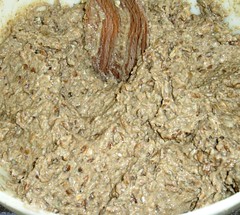
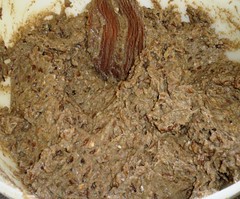

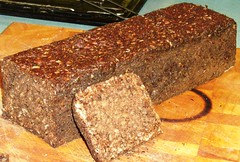

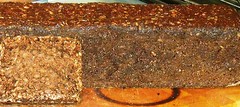
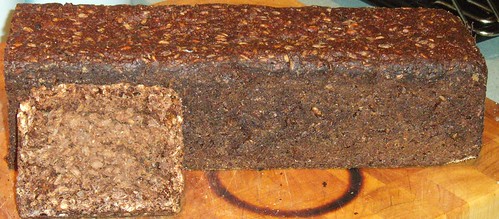
Best wishes
Andy


Comments
Andy,
I've been wondering when you would post about this bread. You have been torturing me waiting to see how your first attempt turned out.
Essentially I think you baked yours the same as I did. I'm glad you agree with me that this should be treated as a steamed pudding to best "cook" it through without a hard outer crust. But as you say the flavor is undeterred.
I like your formula. I have been wondering if one might be able to slightly under cook the berries, expecting them to continue to soften during the cooking. I think any reasonable combination of various grinds of rye grain will produce similar results.
On my next try at this I will scald a larger portion of the flours, hoping for a sweeter result and a darker mailard effect.
Very nice post Andy. This bread is very unusual and I think many owners of Bread are tempted to make it. From my experiments it is a very delicious bread and I hope to learn to do it justice some day.
Eric
Andy, it's the kind of bread that I really love;)
If cooking it is a challenge for you imagine how it's hard for us newcomers!
Andy-
You should send Jeffrey an email with a link to this post of yours. I'm sure he would be pleased with your efforts, and given the detailed explanation of your procedure and the rationale behind why you proceeded as you did, I suspect he might provide some excellent feedback.
Larry
pots turned out, the coloring is more even. But I love the rich browning of rye as that which occurs in baked crust. Andy, they must taste like rye heaven! What if it was steamed first and then browned?
Eric's comment stands out. "On my next try at this I will scald a larger portion of the flours, hoping for a sweeter result and a darker mailard effect."
Do you guys boil your berries in a rice cooker? Ever thought of steaming the bread in it? How about a big rice cooker? An electric fry pan with water in the bottom and... I think my mom has one that could steam two household size loaf pans. It could be rigged with a hamster drip and the probe thermometer could be stuck into a loaf through the top vent. What about a single buffet steam below serving container thingy? Chafing dish?
Mini
As I was reading your post, I suddenly realized my electric roaster (Nesco) would be perfect. The temperature is adjustable, it's plenty deep and large enough for 2 or 3 bread pans, maybe 2 pullmans. A little water in the bottom and a wire rack and we have a steamer/cooker.
Eric
Hi to Mini and to Eric, and others interested inthis thread.
I've been doing a little digging into the "Maillard Reaction" as a result of our conversations about "steaming", and because I came across a discussion Eric was part of here: http://www.thefreshloaf.com/node/16701/steamed-bread-chemistry
I've been reading this extract on the internet just earlier: http://www.rsc.org/ebooks/archive/free/BK9780854045815/BK9780854045815-00001.pdf
Apologies, I haven't referenced it to academic standards, which I know I should as it's an extract from an e-book.
Anyway, I'm just thinking that steaming is a much gentler way to cook food, but the bread will still be taken to temperatures sufficient to achieve Maillard Reactions. As noted in the article, these reactions are varied and complex. But colouration in steaming definitely takes place, allbeit very late in the day.
Mini, I'm afraid the crust produced on the Horst Bandel loaf was too much for us; the outer edge of the crumb started to dry a little, the middle stayed beautifully moist as would be expected. It's too much for me to try and bake a 2kg loaf in this way, and I want to go down the steam route in future. I'm sure you'll both have read my comments about using the coffins at Village Bakery. Just how do I teranslate that to my home oven?
Well, I don't want to wreck my brand new £44 Pullman Pan, that's for sure. So it is not going to sit in water. I reckon I could fill the base of the grill pan with water, and sit the Pullman Pan on the wire, directly above the gently boiling water. But I don't have anything I could use as a lid big enough to encompass the Pullman Pan and trap in the steam.
I don't have any of the fancy devices you refer to: turbo steamers etc.
Well that's still my way forward for this bread.
Eric, I want to know what you've been up to on the "Bread" Challenge? You've not posted that much thus far in the Holiday, and I reckon you're beavering away with a JH related project!!! Well, I've been up to all sorts, and hope to be posting nos. 4 and 5 of the 85 later tomorrow, all being well. Will keep you in suspense til then!
Best wishes
Andy
During the bake or afterward?
From what I know, Pumpernickel is tightly wrapped when it has cooled in lighly oiled plastic. This doesn't always happen and often a peeled apple or wedge will be placed inside the bag or bin with the loaf. Save the dry stuff for altus or feeding your refreshed starter to give it a sour kick!
Mini
Hi Mini
I know I got everything right with the mix for this; it was the baking that I was unhappy with.
Maybe it's the oven profile I got wrong, but I really think there is a better way for homebakers to tackle the heat treatment for this bread. Forcing a 2kg piece of very wet dough, with an element of sugar, to face upto 12 hours in a metal hotbox does not seem quite right to me; I'll look for the steam route thanks.
It kept beautifully all week, no wrapper, except a piece of cling on the end of the crumb.
Good to hear from you
Best wishes
Andy
Hi Andy
I had a very similar result when I attempted Horst Bandel's ryebread last year. Dark fragrant interior and hard hard crust!
I did wrap the bread up in plastic and the crust softened a bit after about four days, and came to the conclusion that the problem was controlling my oven temperature for the long slow bake. I too would be very interested to see if it can be done with steam to give a more even result, I was thinking of using a fish kettle! I've got one somewhere but need to dust it off and see if my pullman will fit in it.
all the best
Zeb
Your loaves look quite tasty.
I haven't read all of the posts, so maybe this has been discussed, but, is it possible that a longer bake at an even lower temperature might help attain a even consistency through the bread?
Thanks Zeb and Ryeaskrye,
A fish kettle sounds ideal, although I don't have one, alas. Does yours have a grid to allow the Pullman Pan to sit out of the water?
I mentioned in the post that I was not happy with the bake profile I used. It is possible that a longer slower bake might work. I did say how difficult that might be to achieve in a home oven...I do mean that, and I think steaming is the way to go. I saw the rye bread in your recent post and thought it looked fantastic, by the way.
Best wishes
Andy
Hi Andy
A quick look on Amazon reveals two basic sizes of fish kettle 18 inch and 24 inch. They come in steel, anodised and a slightly pricey (cough!) copper one. They have tightly fitting lids and they all have inserts that allow you to lift out your salmon. I think mine is fairly light weight and might bow a little hauling out a heavy pullman...it looks something like this one but I think if you spend more then you get a heavier duty kettle
I think they come in different sizes and of course prices, and, Waitrose lend them out to customers to cook whole fish in! Though I have a feeling you are in the North of England, not sure how far Waitrose's arms extend...
best wishes Zeb
Hi Zeb,
Thanks for this info. Yes, we have Waitrose in Newcastle, and Hexham; fine shop, although loans would doubtless be pricey.
I've looked on Amazon. Some good products in the 18" size. Well, that's long enough. Trouble is there is no indication of the height and depth of these pans.
I'm not sure they'll cope with a Pullman Pan weighed down with 2kg of pumpernickel mix?
I'm sure something will turn up soon, but it's a shame my roasting dishes are all too small.
Best wishes
Andy
or a SS salad bar pan with lid? I think there are also racks that fit into the bottoms.
Another idea... I can't help it, must be my background of making fruitcakes but I can't help looking at a traditional Pumpernickel and thinking "fruitcake." What if it came into existance because one year there weren't any fruits, so the grain got lightly "candied" and put into a dough? Fruit of the grain. The rye dough just holds all the grains together as it gets baked/steamed into one loaf.
What happens if the whole grains are soaked and pre-steamed before the main bake?
Mini
Thanks Mini,
Yeah, we used to bake all our Christmans cakes in the coffins which I described above in the "Method" section here. The only difference was we did not put water in the coffin. We still used the tight-fitting lids, so there was reasonable steam generation from within as the cakes gently baked in the dead oven.
When I moved to the more modern bakery, their method of baking fruit cake was to use wooden frames and bake slabs of fruit cake. These were baked in rack ovens, which again, are pretty good regarding steam generation.
I'm sure I'll find something soon that will work. I have well over 2kg of both wholegrain and cracked rye which I'm keen to put to good use!
Best wishes
Andy
Hi Andy
No it's a free service according their website. Click here
The pans themselves are strong enough to hold a tin, I am not sure about the inserts, but one might be able to adapt them. I will measure mine and see if one of my pullmans fits in it and let you know.
I've been looking for a good rye recipe and thought I had found what I wanted when Mini posted her 100% Rye recipe. After two tries ending with very tasty hockey pucks my third try was quite successful, but still not what I was looking for. My next try was Dan Leader's Vollkornbrot. It produced a wonderfully flavored loaf, but when I slid back the lid to see if it had risen enough to bake I did it without thinking and slid it half open before I realized it had already reached the lid. Sliding it back was going to create more problems so I removed it. Since it was baked without a cover the top and sides became almost petrified and very difficult to slice, but still tasty. Even after a week it hadn't softened any, although the taste improved somewhat. I finally saw your post on pumpernickel and decided to give it a try and the result was almost ambrosial. The only problem I had was finding the right size pan. My pullman pan is 19" long, so I need about double the recipe to fill it. The amount of dough produced in the recipe was too much for 2 of my standard loaf pans (8.5x4.5), but not quite enough for 2 of my larger loaf pans. I used 2 larger pans (9x5) but probably should have used one of each. When the bread had risen to almost the top of the pan I covered it with a double layer of greased foil, crimped and then tied into place and set on 2 quarter sheet pans set inside each other to help moderate the bottom temperature. I placed a turkey roaster full of water in the oven, covered, and turned the temp to 350F and left it until I panned the bread... about 4 hours. At that point I lowered the temp to 275F, removed the cover from the roaster, topped it off with hot water and inserted the oven rack on the next level above. When the bread was ready to bake I put it into the oven for 1 hour at 275F, then decreased the temp to 250F for the 2nd hour, then to 225F for the remainder of the bake/steam. At hour 5 the sweetest scent began to emanate from the oven for about an hour, then at the 6.5 hour mark I started to get a distinctly rye aroma lasting for a half hour. After 8 hours I turned off the oven and went to bed. In the AM I removed the loaves from the oven and took them out of their pans and wrapped them in dish towels to stand for 24 hours. When I woke this morning I couldn't wait to try it and sliced into it before brewing the coffee. It is by far the most delicious loaf I have ever baked!
The changes I made to the recipe (can't resist those changes) were as follows: 1) In the sour dough I replaced the dark rye flour with RYE MEAL. 2) With the rye berries - I covered them with boiling water, then in the AM I brought them to a boil, removed the pan from the burner and covered it and allowed them to come to room temperature. 3) In the final dough I used RYE MEAL for the cracked rye grain.
Pictures follow (my 1st upload): 1- oven ready pans, 2- Pumpernickel crumb, 3- Pumpernickel slices.
Wow, it seems to have come out really fantastic!
I have a problem that I still haven't solved: my bread crumbles when I slice it. Sometimes more, sometimes less, but in any case it tends to break. I wouldn't say I overbake my bread because the crumb is moist. I don't really know what to think.
I pay attention to mix the "dough" until it's homogeneous and I also pack it tightly in the tin using a wet teaspoon and levelling the surface.
Any advice?
Razor sharp straight thin knife? Don't use a serrated edge. I use an electric slicer. Maybe dip the knife in cold water first before slicing?
didn't do the trick, but I never tried to wet it. I'll try, thanks, Mini.
I have found that when I bake a rye bread with a high percentage of rye flour in an uncovered pan that, thanks to the Maillard reaction, it develops a very hard crust which does not soften appreciably upon resting. Because the loaf doesn't give much when slicing, the gummy coating that collects on the blade seems to cause the releasing slice to flex and results in a 'stress fracture', usually at the corners, and the crumbling starts. The longer the bake time the harder the crust. When I bake it covered and allow it to cool covered for a few hours it doesn't seem to be an issue. If I bake it covered but cool it uncovered on a rack it takes two or three days of resting before the crust softens enough to no longer be an issue. I have found the wet blade to help when the crust is not hard. Sometimes I have to clean and wet it after each slice, other times I can get 2 slices with a wetting in between before I have to clean and wet it again. Not a problem if you are only doing one or two slices for yourself, but if you are doing a whole loaf it can be rather bothersome.
Hi BjornErik, nicodvb and MiniOven,
Thanks all for your recent posts.
I've had to do a little bit of careful reading through your procedure and revisions Bjorn. I can do imperial measures, but generally work metric. Anyway I've discovered my Pullman Pan is 13 x 3.75 x 3.75 inches. So your Pullman Pan is clearly a wopper. Anyway the recipe I posted was designed for one Pullman Pan as above. Your finding that one of your large and one small pan would have been right for this amount seems correct to me.
I knew from the outset that I had tried to bake this too hot. I'll have to look over your bake profile and do a bit of converting so I can relate it in metric nos. It seems to be much gentler, and you have definitely picked up on Hamelman's falling oven.
Since this post I have made this bread once more. The bake was altogether more successful this time. I found a roasting dish to accomodate the bread pan. I found a couple of steaming devices to use in a wok, and inserted them under the pan. Then I placed a cm of water in the roasting dish. I kept replenishing this water as the baking progressed. After 7 hours I removed the lid form the bread pan, and took out the roasting dish. the base of the loaf was just a trifle damp from sitting close to the water. I finished the bread off upside down in the unlidded bread pan for 1 hour. The baking temperature throughout was 160*C.
After cooling, I wrapped the bread in linen and left for 24 hours before cutting. This latter version is much improved. It is not so hard on the outside. It's only 3 days old and yet we are now getting through it at a rate of knots.
I see the changes made. I'm pretty sure your procedure for the wholegrain is the same as mine. I don't have access to rye meal, so I'm not sure how it differs with Dark Rye. I know Nico, you use a coarse grind of rye, and I suspect this is rye meal. But some of the Dark Rye we get in the UK is pretty coarse. I prefer the rye chops instead of the cracked rye. Again, I know Nico has got his hands on rye chops; looking forward to reports back on how you get on with this.
In summary it's great to receive a post echoing such enthusiasm for the loaf. I have loved making it. However, I still think that full traditional steaming is the way to go. I know the shape is incongruous, and inconvenient for sandwiches, but next time I'm doing it in pudding pots and giving it the full 8 hour steam treatment for 1kg "puds". Hope to report back soon.
Nico, regarding slicing these; I know Mini has passed on some expert advice. All I can say is that I have a SERIOUSLY sharp Giesser serrated bread knife. If I ever have any problem it is that the knife drags on the over-moist crumb. I don't think I've ever had a problem with the dough crumbling before. I know you use the correct high hydration, so one thing I turn back to is what I have questioned before: is your flour up to the mark? It's only something I'm putting out there for you to think about. It's not an easy problem to diagnose on the end of a pc.
Maybe you could study the bake profile BjornErik has posted here, or, what about going for steaming your bread as a trial, as I discussed with Eric?
Sorry I can't give you a magic answer on this. I'll answer your question on amylase by mail very shortly.
Great to hear from all of you; your bread looks fantastic Bjorn
Best wishes
Andy
(and the right one is on its way).
Next time I'll try to adapt you steaming method to the small oven I have and see what comes out.
Hi frelkins,
Thank you for posting, and, particularly for some useful tips on baking this bread. Unfortunately, I'm UK based, so some of the finer points on ovens are maybe not that relevant, but the times are very useful, and I can easily convert to Celsius for temperatures.
I don't know how much of the full discussion you have read, but Eric Hanner and I explored steaming this bread. I was really disappointed with baking, so I used Christmas Pudding pots and steamed for about 9 hours for a 630g pot of mix. I would like to find an efficient way to steam but using a Pullman Pan. I'm going to experiment with that in College, as we have Combination Ovens in the classrooms which will be ideal. This will always be my preferred way to cook these from now on.
As for colour, please take a look at this subsequent post: http://www.thefreshloaf.com/node/17931/horst-bandel039s-black-pumpernickel These loaves darkened up very nicely over the next day or so. Personally, I don't want to go darker than that. If that's not authentic, I'll be content with my inaccuracy. However, black and crunchy, we agree is definitely not correct.
Your idea for soaking the bread in beer sounds great. However, I think the cooked wholegrain portion is one of the special characters of this bread, and I wouldn't look to substitute anything else. I mean, you have to refresh the sour, what's the big deal about soaking a few grains at the same time? All it takes is a bit less than an hour's boiling; they cool quickly enough to add to the final paste.
Yes, I agree, this is an easy bread to make in many ways; but when you take some of the prep, the extremely long cooking cycle, then the long wait to cut into the loaf, this all adds up to considerable skill requirement on the part of the baker. That's the attraction to me.
The only "improvement" I'm now looking for is to bake in large square pans like Pullmans.; I'm really happy with everything else. I'm looking to move on to Volkornbrot now, truth be told. Meantime the HB I make is a fail-safe way to keep my wife utterly content with her lunchtime sandwiches for at least half the week.
Thanks again
Andy
Hi,
I've borrowed these images, to give you an idea of the type of ovemn I worked on to make a lot of commercial bread.
On the "dead" oven, once the bread and confectionery has all been baked, this is my understanding of when the HB loaf is loaded to the oven. We used coffins to bake all our Christmas Puddings: a chunky aluminium case, the same size as a full size baking sheet, and almost the full height of the oven. Fill the base with water, load the puddings in a rack above that, and attach a tight lid. Use a huge peel to load to the back of the oven, and leave to cook in the steam for several hours.
I think this is really where Jeffrey Hamelman is coming from. Hats off to you for working out how to do this in a home oven. I think there are few concessions made to home bakers in Jeffrey's magnificent book. However, as I have years of experience of commercial baking, I quickly work out what I can easily do at home, and what will be a pain.
I really want some form of steam in there to make the bake as gentle as possible. It is admirable that you have gone to the bother of creating a genuine dry baking cycle for this bread; this is not easy. But for me, the right hand edge of your loaf is overdone. I hasten to add, that I bake for 2 in this house, and my wife is the key arbiter in this: her teeth would definitely protest. Me, I'll go with the steam. I love his recipe and formula. I know how to deal with it properly on a commercial level. At home, I really believe this is a far better way to "cook" this fantastic bread.
Thanks very much for contributing to the debate
BW
Andy
Hi all, I am brand new to this forum and so forgive me if I am reopening an old subject already discussed at length. I have been baking our friends Horst's recipe for about a year now and am generally very happy with the taste and colour, however I have hugely varied the water content by only adding about 250g (8.9 ounces) of water compared to the 12.8 oz called for in the recipe, with the suggestion of topping it up with water from the old bread soaker if need be! Even with this reduction I still have a very wet dough - more like a rich fruit cake batter than a dough capable of being shaped. I note your adjusted recipe uses 150g of additional water and was wondering if the recipe has a printing error or if I am just missing something?